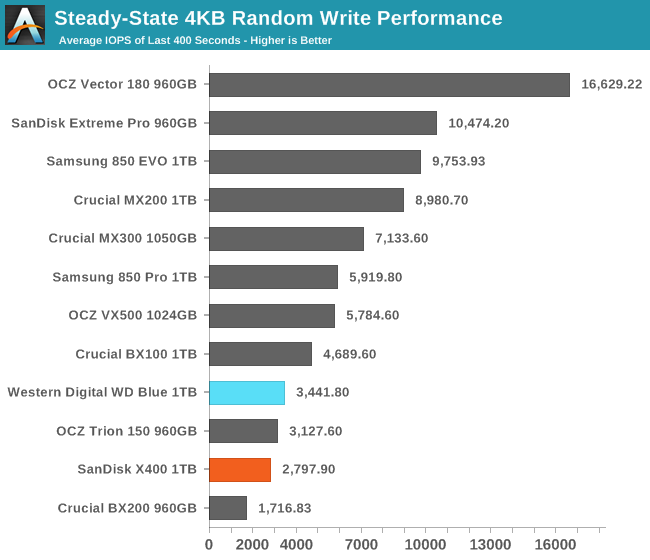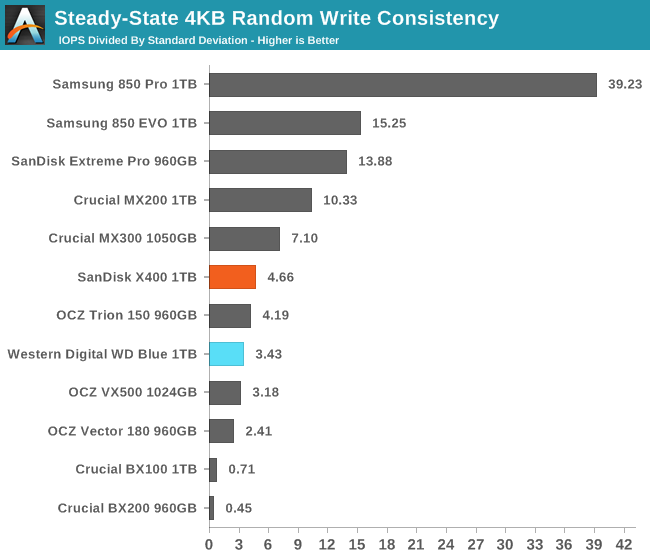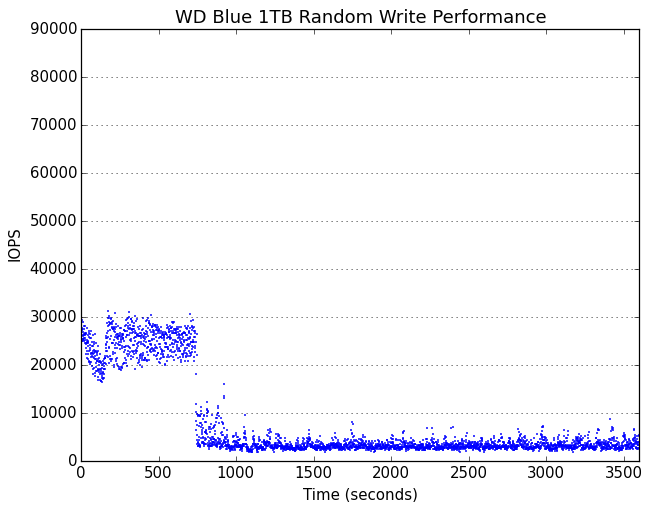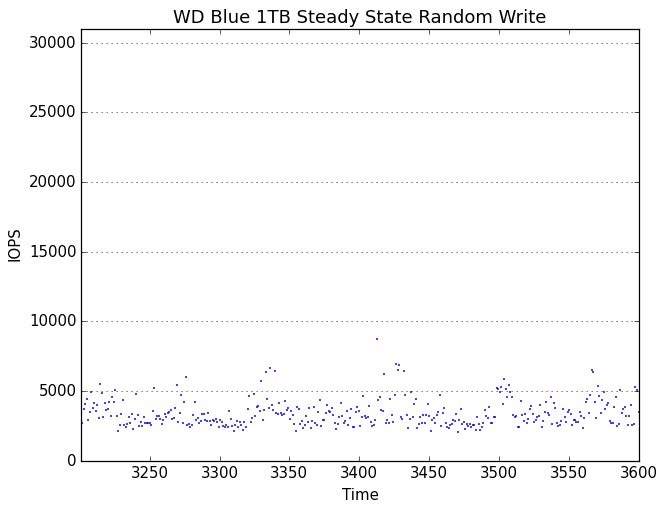The Western Digital Blue (1TB) SSD Review: WD Returns to SSDs
by Billy Tallis on October 11, 2016 8:00 AM EST- Posted in
- SSDs
- Storage
- Western Digital
- SanDisk
Performance Consistency
Our performance consistency test explores the extent to which a drive can reliably sustain performance during a long-duration random write test. Specifications for consumer drives typically list peak performance numbers only attainable in ideal conditions. The performance in a worst-case scenario can be drastically different as over the course of a long test drives can run out of spare area, have to start performing garbage collection, and sometimes even reach power or thermal limits.
In addition to an overall decline in performance, a long test can show patterns in how performance varies on shorter timescales. Some drives will exhibit very little variance in performance from second to second, while others will show massive drops in performance during each garbage collection cycle but otherwise maintain good performance, and others show constantly wide variance. If a drive periodically slows to hard drive levels of performance, it may feel slow to use even if its overall average performance is very high.
To maximally stress the drive's controller and force it to perform garbage collection and wear leveling, this test conducts 4kB random writes with a queue depth of 32. The drive is filled before the start of the test, and the test duration is one hour. Any spare area will be exhausted early in the test and by the end of the hour even the largest drives with the most overprovisioning will have reached a steady state. We use the last 400 seconds of the test to score the drive both on steady-state average writes per second and on its performance divided by the standard deviation.

With a slight increase in out of the box overprovisioning, it is unsurprising to see the WD Blue improve on the SanDisk X400's steady-state random write performance. The WD Blue overtakes the OCZ Trion 150 as the fastest planar TLC NAND SSD, but doesn't catch up to the MLC or 3D TLC drives.

The WD Blue has slightly worse performance consistency than the X400, but not low enough to be cause for concern.
 |
|||||||||
| Default | |||||||||
| 25% Over-Provisioning | |||||||||
Before reaching steady state, the WD Blue hovers between 20k and 30k IOPS, a significant improvement over the X400. Several other competitors have higher peak performance, but are either less consistent during the early phase of the test or don't last as long before dropping to steady state.
 |
|||||||||
| Default | |||||||||
| 25% Over-Provisioning | |||||||||
Upon reaching steady state, the WD Blue varies from roughly 2500 IOPS to 5000 IOPS, with short bursts of slightly higher performance. With extra overprovisioning the base performance of the WD Blue doesn't change but the upper limit of its normal band of performance increases to around 10k IOPS and the peaks reach 25k.










75 Comments
View All Comments
HollyDOL - Wednesday, October 12, 2016 - link
Indeed, all those companies had hiccups, but out of those two long term RMAing rate at friend's computer shop for Seagate is almost double of WD's (like... it was 9% of sold WD and 18% of sold Seagates, numbers being example, not actual ones).Then againt, it's 7 weeks since I had WD Red failure & RMAing.
so... backup, backup, backup and then again backup...
mapesdhs - Friday, October 14, 2016 - link
Never ceases to amaze me the number of business users I come across that have no backup of any of their systems or data at all.jamyryals - Tuesday, October 11, 2016 - link
Wow, I didn't realize the 1TB prices had come down so much. Pretty awesomeImpulses - Wednesday, October 12, 2016 - link
Prices haven't budged much in over a year, I paid $300-ish (ea.) for 2x 1TB EVOs back around the Skylake launch, well over a year ago... The X400 was already cheaper at the time, but I was fine with the slight premium for the faster EVO. WD is basically launching an average to sub average drive at nearly the price point that an EVO has held for 12+ months...mapesdhs - Friday, October 14, 2016 - link
In some cases they've gone way up. The 850 EVO was pretty cheap in Jan/16, since when it's skyrocketed.Jad77 - Tuesday, October 11, 2016 - link
Lets hope the Black drives, when they make an appearance, are NVMe - in U.2 and M.2 form factors.plopke - Tuesday, October 11, 2016 - link
I would say my experience with WD is about 3/5 and sandisk 4/5 and I mean the complete picture product quality,product description,price,support,drivers,firmware,....Curious how this take over will go , how they will use sandisk brand name and knowledge. I fear it will become a typical , safe cost because of the purchase , dropped support for products , confused technical support people ,.... but I can always hope.
cknobman - Tuesday, October 11, 2016 - link
I think you have a typo in your charts, the 1TB drive is showing $299.Other outlets are listing it as $199.
Ryan Smith - Tuesday, October 11, 2016 - link
I just double-checked with WD and it's definitely $299. If anyone has it listed at $199, then that would seem to be in error.cknobman - Tuesday, October 11, 2016 - link
Yep you are correct. Thanks!Now I'm sad, deep down I knew $199 was too good to be true :(